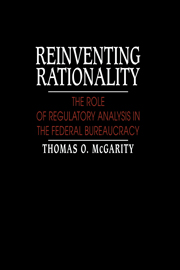Book contents
- Frontmatter
- Contents
- Acknowledgments
- Abbreviations
- Introduction
- Part I The clash of regulatory cultures
- 1 Rational analysis as regulatory reform
- 2 Evolution of the regulatory analysis program
- Part II Regulatory analysis in theory and practice
- Part III Structuring regulatory analysis into the decisionmaking process
- Part IV Review of regulatory analysis
- Part V Conclusions
- Notes
- Bibliography
- Index
2 - Evolution of the regulatory analysis program
Published online by Cambridge University Press: 16 October 2009
- Frontmatter
- Contents
- Acknowledgments
- Abbreviations
- Introduction
- Part I The clash of regulatory cultures
- 1 Rational analysis as regulatory reform
- 2 Evolution of the regulatory analysis program
- Part II Regulatory analysis in theory and practice
- Part III Structuring regulatory analysis into the decisionmaking process
- Part IV Review of regulatory analysis
- Part V Conclusions
- Notes
- Bibliography
- Index
Summary
Although agencies were never free to disregard the impact of their rules on regulatees and the public, formal requirements that agencies prepare documents detailing those impacts have existed for about two decades. The idea probably originated with the National Environmental Policy Act of 1969 (NEPA). NEPA's real bite was in its requirement that agencies prepare an Environmental Impact Statement (EIS) for every proposal for legislation or other major federal action significantly affecting the quality of the human environment. The EIS was required to describe: (1) the environmental impact of the proposed action; (2) any unavoidable adverse environmental effects; (3) alternatives to the proposed action; (4) the relationship between local short-term uses of environmental resources and the maintenance and enhancement of long-term productivity; and (5) any irreversible and irretrievable commitments of resources. Although agencies initially regarded NEPA as a wasteful impediment to the attainment of their programmatic goals, the courts demanded strict adherence to NEPA's analytical requirements, and the agencies soon began to hire employees with expertise in environmental impact analysis.
As the agencies began to write NEPA into their standard operating procedures, observers noted that compliance with NEPA's analytical requirements did not ensure that agency action comported with NEPA's substantive goals. Indeed, cynics suggested that agency staff often drafted lengthy EISs in excruciating detail to ensure that busy decisionmakers would not read them and therefore would not be influenced by them. Perhaps the most cogent criticism of the environmental impact assessment process was that it presumed an unrealistic decisionmaking process “characterized by abstract rationality and focused on a single responsible decision-maker who, even if he did exist, could hardly be expected to undertake the investigation of alternatives that the Act requires.” …
- Type
- Chapter
- Information
- Reinventing RationalityThe Role of Regulatory Analysis in the Federal Bureaucracy, pp. 17 - 26Publisher: Cambridge University PressPrint publication year: 1991

